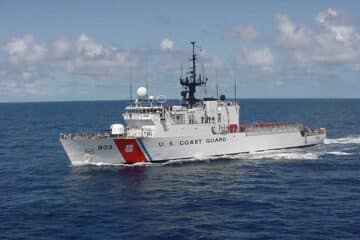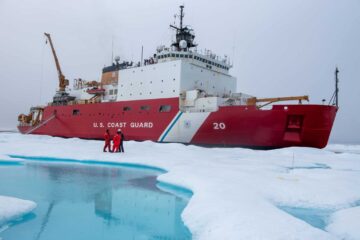Lieutenant SondraKay Kneen, U.S. Coast Guard (USCG) Spokesperson replied to Naval News’ inquiry via email on March 2022.
“The Coast Guard responds to numerous and highly dynamic maritime threats across the Service’s eleven statutory missions. To counter maritime threats, the Coast Guard deploys multi-mission platforms that respond around the globe, whether to interdict drugs in the Caribbean Sea or prosecute Illegal, Unreported, and Unregulated (IUU) fishing in the Western Pacific Ocean. While some at-sea interdictions involve high-speed pursuits, missions in remote locations also require operational endurance.
Coast Guard multi-mission platforms are designed to optimize the trade-off between speed and endurance and allow for deployment in multiple and varied operational theaters. Larger multi-mission platforms, like the National Security Cutter, deploy subordinate surface and air assets, which when combined, encompass a range of complementary capabilities that Coast Guard operators use to effect interdictions on a wide variety of vessels operating in the maritime domain.
“Search and rescue; drug and migrant interdiction; ports, waterways, and coastal security; and defense readiness missions are among many Coast Guard missions that require assets to operate at high speeds. Asset speed is one of the many requirements the Coast Guard considers when developing capabilities and acquiring assets. Consequently, asset speed has increased to meet documented needs. Operational requirements generation for future assets will consider speed, among other factors, to ensure Coast Guard operators can continue to operate safely and effectively in multiple environments.”
Lieutenant SondraKay Kneen, U.S. Coast Guard Headquarters Spokesperson
USCG assets for high-speed and endurance pursuits include their large cutters, the Legend-class National Security Cutter (NSC or WMSL) and their medium cutters, the legacy Famous and Reliance-class (WMEC) and the upcoming Heritage-class Offshore Patrol Cutter (OPC or WMSM) that can deploy Rigid Hull Inflatable Boats (RHIB).
The NSC can sail at 28 knots and the older WMECs at around 19 knots, respectably, but it’s their smaller RHIBs, the Long-Range Interceptor II and the Cutter Boat Over-the-Horizon IV, that often pursue and come close to the (small) high-speed targets.
The 35-foot Long-Range Interceptor II (LRI-II) has a speed of around 40 knots and a 240 nautical mile range. LRI-II has a complement of up to 15 people and has an enclosed cabin.

The NSC’s 26-foot Over-the-Horizon IV (OTH-IV) Cutter Boat has a speed of around 42 knots and a range of 200+ nautical miles. The NSC can carry two OTH-IVs and the OPC one to three OTH-IV Cutter Boats. Naval News has covered the OTH-IV as found here. More information about the USCG RHIBs can be found here.

Another Coast Guard surface asset is the Fast Response Cutter (FRC). The FRC can sail at 28+ knots for 2,500 nautical miles and is armed with a single Mark 38 Mod 2 25mm autocannon at the bow and four crew-served stations for heavy .50 caliber and medium 7.62mm caliber machine guns. The FRC can carry one OTH-IV Cutter Boat that is launched from the FRC’s stern ramp.

Speed is essentially important when it comes to U.S. Coast Guard’s high-speed endurance pursuit missions. “In the maritime transit zone, including both the Caribbean Sea and the Eastern Pacific Ocean, high-speed pursuits to interdict narcotics and migrant traffickers occur nearly every day in the open ocean and littoral zones. The Coast Guard is most successful at interdicting high-speed vessels when using a force package that combines maritime patrol aircraft, unmanned aerial surveillance, airborne use of force, and surface pursuit assets.
Each maritime pursuit chase is unique, and factors such as ambient lighting and sea state, target speed and actions, and the target’s proximity to land directly influence interdiction results. Despite these myriad factors, the Coast Guard has an approximately 90% interdiction success rate, once starting pursuit operations, over the last three years. Enhanced pursuit capabilities, including unmanned aerial surveillance, in combination with changes in pursuit tactics, like airborne use of force, and refinement of tactical geometry assessments may have increased the recent level of interdiction success,” Lieutenant Kneen said.
Information on the USCG’s current aviation assets can be read here; however, their fielded unmanned aerial systems (UASs) are still to be determined as to if the USCG will acquire them or lease them as mentioned by Rear Admiral Chad Jacoby, USCG, at SNA 2022.

With motor engine performance and high-speed boat designs constantly improving, and the possibility that these high-speed vessels might become more accessible to civilians in the future, how then will the U.S. Coast Guard handle the issues of faster speed crafts? USCG Headquarters replied, “The Coast Guard continually validates response capabilities required to meet current and anticipated threats in the maritime domain through an iterative and rigorous analytical process to develop operational requirements. These requirements are critical, indispensable drivers of the performance and capability of a Coast Guard system or asset over its service life. Requirements are traced throughout design, development, and testing to ensure Coast Guard operational forces receive the desired capabilities.
“The Coast Guard is executing a number of acquisition programs to modernize its cutter and rotary wing fleets. The Offshore Patrol Cutter will deliver improved capabilities to supplement the maritime coverage of the Fast Response Cutters and the National Security Cutters, and replace the aging fleet of 210-foot and 270-foot Medium Endurance Cutters that are increasingly difficult and expensive to support and maintain. To fulfill a shifting mission set inspired by geopolitical and environmental uncertainty in the high latitudes, the Coast Guard is acquiring Polar Security Cutters designed to have more speed and endurance than its current fleet of Polar Icebreakers. Additionally, the Coast Guard is pursuing a transition to a single-airframe MH-60 fleet to improve mission effectiveness due to greater range and endurance. Acquisition programs like these ensure that the Coast Guard will remain ready to respond to and operate in the modern maritime environment.”
More information about the USCG’s Polar Security Cutters and icebreakers can be read here.







